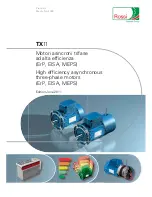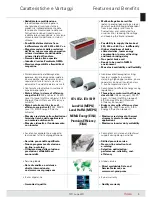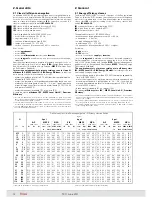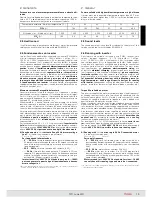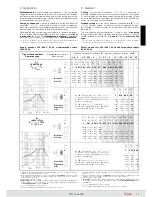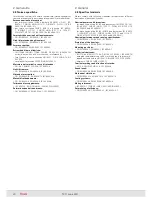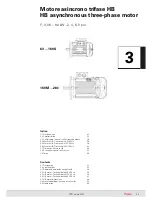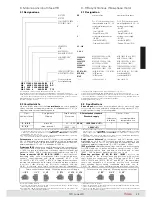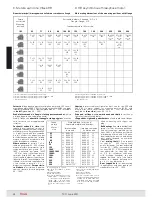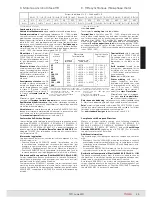
12
TX11 June 2011
2. Generalità
2. General
2.1 Classi di effi cienza energetica
La direttiva 2009/125/CE per la progettazione ecocompatibile dei pro-
dotti connessi all'energia (direttiva ErP, Energy-related Products) stabi-
lisce che i motori elettrici asincroni trifase destinati al mercato europeo
siano in classe di effi cienza energetica
IE2
o superiore, secondo le 3
classi di rendimento defi nite dalla
IEC 60034-30
:
IE1
: classe di effi cienza standard (sostituisce EFF2);
IE2
: classe di effi cienza alta (sostituisce EFF1);
IE3
: classe di effi cienza premium.
I limiti di applicabilità della IEC 60034-30 sono:
− motori asincroni trifase a 50 o 60 Hz;
− singola polarità: 2, 4, 6 poli;
− tensione di alimentazione max 1000 V;
− campo di potenza 0,75 ... 375 kW;
− servizio continuo o intermittente S3 80% o superiore.
Sono esclusi:
− motori
autofrenanti
;
− motori
ATEX
;
− motori per
alimentazione
esclusiva da
inverter
;
− motori
integrati
in macchine che non possono essere testati sepa-
ratamente.
Analoghe regolamentazioni in materia di risparmio energetico sono vi-
genti per i mercati di Stati Uniti e Canada (
EISA
, Energy Independence
and Security Act), Austrialia e Nuova Zelanda (
MEPS
, Minimum Ener-
gy Performance Standard).
I motori non autofrenanti del presente catalogo sono in classe di
effi cienza IE2
1)
, MEPS Level 1A
2)
, EISA Energy Effi cient
3)
,
in funzione
delle diverse tensioni di alimentazione, eccetto:
− motori con potenze inferiori a 0,75 kW (fuori dal campo di applica-
bilità della IEC 60034-30);
− motori con potenze o corrispondenza grandezza-potenza non nor-
malizzata - contrassegnata ai cap. 3.4 ... 3.6 - per i quali la potenza
e i dati di targa sono riferiti al servizio intermittente S3 70% (S2 30
min. per motori MEPS).
− motori autofrenanti (standard IE1, a richiesta IE2).
A richiesta classe
effi cienza IE3
1)
, MEPS Level Heff-A
2)
, Premium
Effi ciency
3)
.
1) Secondo IEC 60034-30, metodo di calcolo secondo IEC 60034-2-1, grado di incertezza
basso, tensione di alimentazione nominale ∆230 Y400 V 50 Hz, ∆265 Y460 V 60 Hz (grand.
160S), ∆400 V 50 Hz (grand.
160M).
2) Secondo MEPS 2006 AS/NZS 1359:5:2004 Level 1A, metodo di calcolo del rendimento
secondo AS/NZS 1359:102.3 (Test Method A), alimentazione nominale ∆240 Y415 V 50 Hz.
3) Secondo NEMA EISA 2007, metodo di calcolo secondo CSA C390-1, tensione di alimenta-
zione nominale ∆230 Y460 V 60 Hz.
2.1 Energy effi ciency classes
The directive 2009/125/EC for the «Ecodesign» of the Energy-related
Products (directive ErP,), decrees that the asynchronous three-phase
electric motors addressed to the European market are in energy effi -
ciency class
IE2
or higher, according to the 3 effi ciency classes defi -
ned by
IEC 60034-30
:
IE1
: standard effi ciency class (replacing EFF2);
IE2
: high effi ciency class (replacing EFF1);
IE3
: premium effi ciency class.
The applicability limits of IEC 60034-30 are:
− asynchronous three-phase motors at 50 or 60 Hz;
− one-speed: 2, 4, 6 poles;
− supply voltage max 1000 V;
− power range 0,75 ... 375 kW;
− continuous or intermittent duty S3 80% or higher.
Excluding:
−
brake
motors;
−
ATEX
motors;
− motors for exclusive
supply
by
inverter
;
− motors
integrated
in machines which cannot be tested separately.
Similar regulations concerning energy saving are in force for the mar-
kets of the United States and Canada (
EISA
, Energy Independence
and Security Act), Australia and New Zealand (
MEPS
, Minimun Energy
Performance Standard).
The non-brake motors of present catalog are in effi ciency class
IE2
1)
, MEPS Level 1A
2)
, EISA Energy Effi cient
3)
,
according to the rele-
vant supply voltages, except for:
− motors having powers lower than 0,75 kW (outside the applicability
limit of IEC 60034-30);
− motors having power or motor power-to-size correspondence not
according to standard - highlighted at ch. 3.4 ... 3.6 - for which po-
wer and nameplate data refer to intermittent duty S3 70% (S2 30
min for MEPS motors).
− brake motors (standard IE1, on request IE2).
On request
effi ciency class IE3
1)
, MEPS Level Heff-A
2)
, Premium
Effi ciency
3)
.
1) According to IEC 60034-30, calculation method according to IEC 60034-2-1, low uncertainty
degree, nominal supply voltage ∆230 Y400 V 50 Hz, ∆265 Y460 V 60 Hz (size
160S), ∆400
V 50 Hz (size
160M).
2) According to MEPS 2006 AS/NZS 1359:5:2004 Level 1A, efficiency calculation method
according to AS/NZS 1359:102.3 (Test Method A), nominal supply ∆240 Y415 V 50 Hz.
3) According to NEMA EISA 2007, calculation method according to CSA C390-1, nominal
supply voltage ∆230 Y460 V 60 Hz.
Definizione classi di efficienza energetica - Efficiency class definition
N
P
N
2 pol.
4 pol.
6 pol.
ErP
MEPS
EISA
ErP
MEPS
EISA
ErP
MEPS
EISA
400V - 50Hz
415V - 50Hz
460V - 60Hz
400V - 50Hz
415V - 50Hz
460V - 60Hz
400V - 50Hz
415V - 50Hz
460V - 60Hz
kW
hp
IE1
IE2
IE3
Level
Level
NEMA
NEMA
IE1
IE2
IE3
Level
Level
NEMA
NEMA
IE1
IE2
IE3
Level
Level
NEMA
NEMA
1A
Heff-A Efficient Premium
1A
Heff-A Efficient Premium
1A
Heff-A Efficient Premium
00
0,75
00
1
,0
72,1 77,4 80,7 78,8 81,4 75,5 77
,0
72,1 79,6 82,5 80,5 82,9 82,5 85,5 70
,0
75,9 78,9 76
,0
78,8 80
,0
82,5
00
1,1
0 00
1,5
75
,0
79,6 82,7 80,6 83
,0
82,5 84
,0
75
,0
81,4 84,1 82,2 84,5 84
,0
86,5 72,9 78,1 81
,0
78,3 80,9 85,5 87,5
00
1,5
0 00
2,2
77,2 81,3 84,2 82,6 84,8 84
,0
85,5 77,2 82,8 85,3 83,5 85,6 84
,0
86,5 75,2 79,8 82,5 79,9 82,4 86,5 88,5
00
1,85
00
2,5
78,6
1)
82,3
1)
85,1
1)
83,4
1)
85,5
1)
85,5
1)
86,5
1)
78,6
1)
83,6
1)
86,1
1)
84,2
1)
86,2
1)
87,5
1)
89,5
1)
76,6
1)
80,9
1)
83,5
1)
80,9
1)
83,3
1)
87,5
1)
89,5
1)
00
2,2
0 00
3
,0
79,7 83,2 85,9 84,1 86,2 85,5 86,5 79,7 84,3 86,7 84,9 86,9 87,5 89,5 77,7 81,8 84,3 81,9 84,2 87,5 89,5
00
3
,00 00
4
,0
81,5 84,6 87,1 85,3 87,2 87,5
1)
88,5
1)
81,5 85,5 87,7 86
87,8 87,5
1)
89,5
1)
79,7 83,3 85,6 83,5 85,6 87,5
1)
89,5
1)
00
4
,00 00
5,4
83,1 85,8 88,1 86,3 88,1 87,5
1)
88,5
1)
83,1 86,6 88,6 87
,0
88,7 87,5
1)
89,5
1)
81,4 84,6 86,8 84,7 86,7 87,5
1)
89,5
1)
00
5,5
0 00
7,5
84,7 87
,0
89,2 87,2 88,9 88,5 89,5 84,7 87,7 89,6 87,9 89,5 89,5 91,7 83,1 86
,0
88
,0
86,1 87,9 89,5 91
,0
00
7,5
0 0
10
,0
86
,0
88,1 90,1 88,3 89,9 89,5 90,2 86
,0
88,7 90,4 88,9 90,4 89,5 91,7 84,7 87,2 89,1 87,3 89
,0
89,5 91
,0
00
9,2
0 0
12,5
86,9
1)
88,8
1)
90,7
1)
88,9
1)
90,4
1)
89,5
1)
90,2
1)
86,9
1)
89,3
1)
91
1)
,0
89,4
1)
90,9
1)
89,5 91,7
1)
85,6
1)
88
1)
89,7
1)
88
1)
89,6
1)
89,5
1)
91
1)
,0
0
11
,00 0
15
,0
87,6 89,4 91,2 89,5 90,9 90,2 91
,0
87,6 89,8 91,4 89,9 91,3 91
,0
92,4 86,4 88,7 90,3 88,7 90,2 90,2 91,7
0
15
,00 0
20
,0
88,7 90,3 91,9 90,3 91,6 90,2 91
,0
88,7 90,6 92,1 90,8 92,1 91
,0
93
,0
87,7 89,7 91,2 89,6 91
,0
90,2 91,7
0
18,5
0 0
25
,0
89,3 90,9 92,4 90,8 92,1 91
,0
91,7 89,3 91,2 92,6 91,2 92,4 92,4 93,6 88,6 90,4 91,7 90,3 91,6 92,4 93
,0
0
22
,00 0
30
,0
89,9 91,3 92,7 91,2 92,4 91
,0
91,7 89,9 91,6 93
,0
91,6 92,8 92,4 93,6 89,2 90,9 92,2 90,8 92,1 92,4 93
,0
0
30
,00 0
40
,0
90,7 92
,0
93,3 92
,0
93,1 91,7 92,4 90,7 92,3 93,6 92,3 93,4 93
,0
94,1 90,2 91,7 92,9 91,6 92,8 93
,0
94,1
0
37
,00 0
50
,0
91,2 92,5 93,7 92,5 93,6 92,4 93
,0
91,2 92,7 93,9 92,8 93,8 93
,0
94,5 90,8 92,2 93,3 92,2 93,3 93
,0
94,1
0
45
,00 0
60
,0
91,7 92,9 94
,0
92,9 93,9 93
,0
93,6 91,7 93,1 94,2 93,1 94,1 93,6 95
,0
91,4 92,7 93,7 92,7 93,7 93,6 94,5
0
55
,00 0
75
,0
92,1 93,2 94,3 93,2 94,2 93
,0
94,1 92,1 93,5 94,6 93,5 94,4 94,1 95,4 91,9 93,1 94,1 93,1 94,1 93,6 94,5
0
75
,00
100
,0
92,7 93,8 94,7 93,9 94,8 93,6 95
,0
92,7 94
,0
95
,0
94
,0
94,9 94,5 95,4 92,6 93,7 94,6 93,7 94,6 94,1 95
,0
0
90
,00
125
,0
93
,0
94,1 95
,0
94,2 95
,0
94,5 95
,0
93
,0
94,2 95,2 94,4 95,2 94,5 95,4 92,9 94
,0
94,9 94,2 95
,0
94,1 95,8
110
,00
150
,0
93,3 94,3 95,2 94,5 95,3 94,5 95
,0
93,3 94,5 95,4 94,7 95,5 95
,0
95,8 93,3 94,3 95,1 94,5 95,3 95
,0
95,8
1) Valore limite di rendimento ottenuto per interpolazione.
1) Effi ciency limit value obtained through interpolation.
Summary of Contents for TX11 Series
Page 2: ......
Page 203: ...203 TX11 June 2011...

